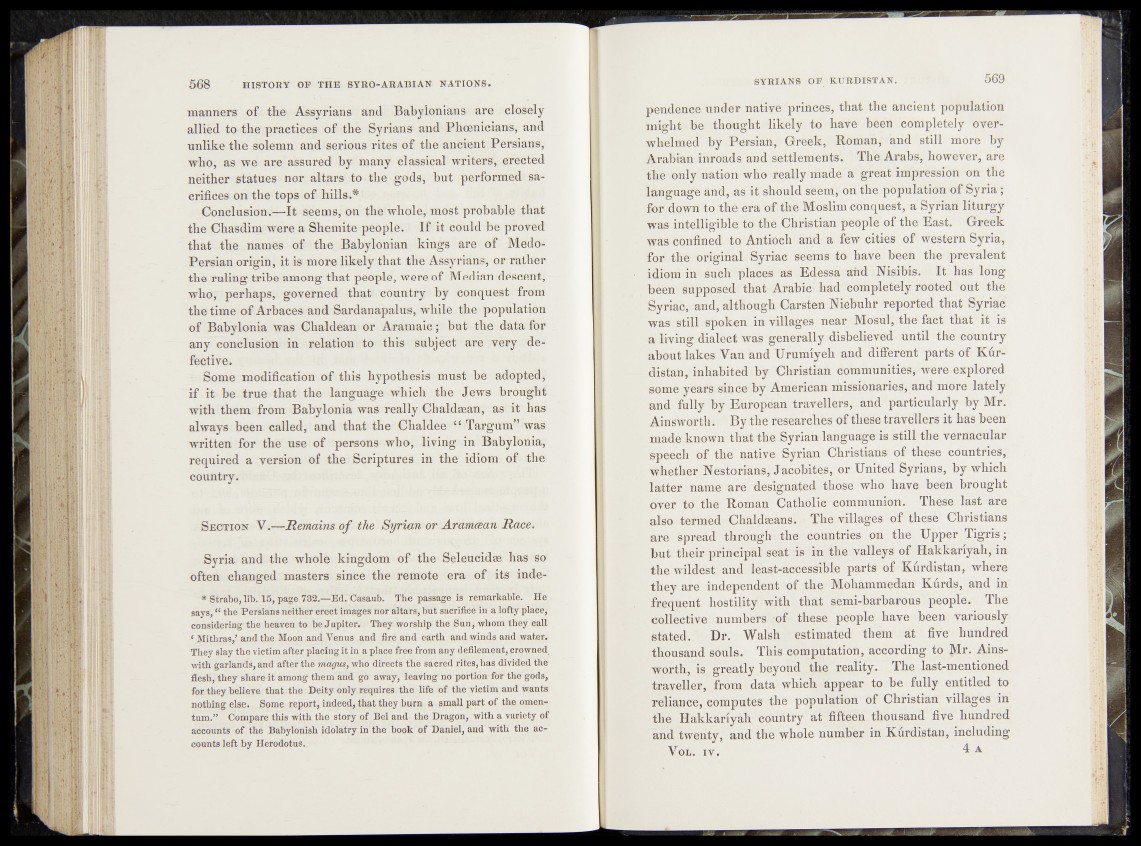
manners of the Assyrians and Babylonians * are closely
allied to the practices of the Syrians: and Phoenicians, and
unlike the solemn andiseiaons rites of the»ancient #ersians|
who, as we arc assured by many classical writers, erected
neither statues nor -altars'-to • the gods, but performed; sri^
orifices on the tops of hills.#
Conclusion.—It seems, on the whole, most probable that
the Chasdim were a Shemite people». • I f it could be* proved
that the names of the Babylonian kings are of Med'o-
Persian origin, ills more likely that the Assyrians, or rather
the ruling tribe among that people, were of Median
who, perhaps, governed that country by conquest from
the time of Arbaces and Sardanapalus, while the population
of Babylonia was Chaldean or Aramaic ? but the data for
any conclusion in relation to this subject are very defective.
- Some modification of this hypothesis* must he;^adopted,
if it be true that the language which the JewstSbrOifpH
with them from Babylonia was really Chaldsean, as! it has
always been called, and that the Chaldee <CiTargum” was
written for the use of persons who, living in Babylonia/
required a version of the Scriptures in the idiom of the
country.
Section V.—Remains of the Syrian or Arameean Race.
Syrian and the whole kingdom of the Seleuoidse has so*
often changed masters since the remote era of its inde-
* Strabo,lib. 1 5 ,p ag e732.—Ed. Casaub. The passage is remarkable. He,
says, “ the Persians neither erect images nor altars, but sacrifice in a lofty place,
considering the heaven to be Jupiter. They worship the Sun, whom they call
‘ Mithras/ and the Moon and Venus and fire and earth and winds and water.
They slay the_victim after placing it in a place free from any defilement, crowned,
with garlands, and after the moyws, who directs the sacred rites, has divided the
flesh, they share it among them and go away, leaving no portion for the gods,
for they believe th a t the Deity only requires the life of the victim and wants
nothing else. Some report, indeed, that they burn a small part of the omentum.”
Compare this with the story of Bel and the Dragon, with a variety of
decounts of the Babylonish idolatry in the book of Daniel, and with the accounts
left by Herodotus.
pendencel%nder native princes, that the ancient population
migbri*bêp.th<foght - likely to have^ been- completely overwh
elmed ^; Persian, Greek, Roman, arid still more by
Arabian inroads and settlements. ' The Arabs,'however, are
the only nation who really made a* grèat impression on the
Sriguage aridy as it should |ië&n$, on the populritiitf of Syria;
fori down toéhqjera of thè Miosliria ucfeqrieSt, a Syrian liturgy
was intelligible'!t©> the Christian peop®®o€*tbè East." Greek
was confinèdyyÉo Antioch and a few cities1 of? western Syria,
fori the original Syriac seems to have been the prevalent
idiom in >such places as Edessa arid Nisibis. It has long
been supposed that Arabic* had completely routed out the
Syriac, mad, although Carsten- Mebuhr reported that Syriac
was still spoken imiriiiriges nearuMosik the-fact that it is
a living dialect was generally.'disbelieved untib the country
about lakes Van and Urumiyrib and different parts of Krir-
distan, inhabited by Christian communities,* were-explored
some years sincahy American missionaries, and more lately
arid fully by^European travellers’, and particularly by Mr.
Ainsworth. By the researches' of these travellers ft has been
made*,known that the Syrian -lari guage is1 Stil 1 the vernacular
spëech of the native Syrian Christians ofoihsesfe countries,
whether Nestoriari%£ Jacobites, or United.Syrians, by which
latter name are designated fla fc vvho have been brought
over tottÊè Roman Catholic communion. Theseraat are
also termed Chaldeeans; The villages-: of^hes^ Christians
are spread through'the countries on the Upper.Tigris;
hut their principal seat%is in the valleys of' Hakkariyah, in
the wildest and le'astraccessible parts of Krirdiatan* where
they are independent -of the. Mohammedan Kurds, and in
frequent hostility with that semi-barbarous people. The
collective numbers of these people have been variously
stated. Dr. Walsh estimated1 them at five hundred
thousand soiils. This computation, according to ^ r . Ainsworth,
is greatly beyond the reality. The last-inentioned
traveller, from data which* appear to be fully entitled to
reliance, computes the population of Christian villages in
the Hakkariyah country at fifteen thousand five hundred
and twenty, and the whole number in Kurdistan, including
Vol. iv. *